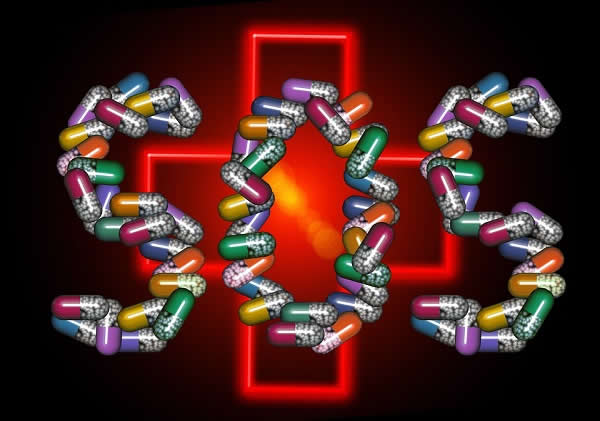Positive Health Online
Your Country

The Bug Paradox
by Rajgopal Nidamboor(more info)
listed in infections and inflammation, originally published in issue 274 - November 2021
https://firstindia.co.in/public/epapers/April2021/161903242122042021_First%20India%20Lucknow.pdf
The use of antibiotics is based on the paradigm there is a battle in progress in the body and it must be resolved – and, that the body is not capable of success without drug support. Antibiotics ‘kill’ microorganisms related to a given illness or disease, all right; they also impede their duplication. The downside is disease-causing bacteria have the innate ability to resist drugs or antibiotics, just like our bodies defy bacteria. This is one reason why your doctor may increase the dos-age of your medicine even when the ‘cause’ or ‘character’ of infection is the same as before. Be-sides, antibiotics do not produce immune-stimulating effects; they lead to ‘drug-dependence,’ or side-effects – some of them serious – including dysbiosis, or microbial imbalance in the body. When Canadian researchers emerged with a simple fungus found in a dirt sample as the key to killing some of the newest strains of antibiotic-resistant bacteria, known as ‘superbugs,’ it set the ball rolling. Their study highlighted a natural fungal product capable of disarming the bacteria’s genetic defences while allowing the once-powerless anti-biotics to work again. Yet another study conducted in Bengaluru reported that scientists had successfully developed a novel way of attacking drug-resistant bacteria. This new thrust apparently targets the bacterial cell mem-brane, right from the word go – directly. What’s interesting is the study concurred that patients would not require multiple dosages of the same medicine.
Courtesy Pixabay
This is certainly a roseate turnaround – a small, petite step, but a useful leap, in the right direction. Yet, the fact of the matter is microorganisms, or bacteria, are smart operators. They are crafty at beating our radar each time we come up with something new – even if it is something spectacular or ‘never-used-before’ new-fangled idea.
It is a fact that new, strikingly infectious, and resurgent illnesses, or diseases, have been growing around our planet, with disturbing intensity and progressing more rapidly than ever before. The latest, also diabolical, an example is COVID-19. This pandemic of pandemics not only signals a crisis in human history, but also the tizzy dance of mutual adaptation that we ‘share’ with our microbial fellow travellers. We have got to only blame ourselves for such a nasty reality and complexity. We have brought the ‘wolf ’ through the door by rendering, and disturbing, the natural fabric of our environment, changing our behaviours and, ironically, by our resourcefulness to increasing the length and quality of our lives.
So, how – and, most significantly, where – have we gone wrong? To summarize Arno Karlen PhD, a psychoanalyst, re-searcher, and author, “For each new disease known to the general public, there are a dozen others; because, the wheels of bio-logical change keep turning faster. The shared evolution of humans and microbes has accelerated to a frenzied pace. For example, much has been written about AIDS, but much less about other new diseases. Our scientific and historical research is fragmented, like pieces of mosaic rarely assembled in more bits and patches. We have been slow to understand that we live in a new bio-cultural era. For decades, we cherished the myth that infectious diseases were fading forever. This was a posture born of inherited optimism.”
Karlen’s words speak of one inescapable truth – about new emerging viruses and the increase in microbial resistance to drugs. You get the point. Without seeing our larger evolutionary picture, we cannot respond intelligently to challenges facing our health and survival. To pick one example – for 10,000 years, since the first hunter-gatherers settled in villages, infections killed more people than war and famine. New diseases, as is obvious, do not fall from the sky or leap from some mysterious black box. “Parasitism and disease are a natural, in fact necessary, part of life. They are fundamental to the existence of everything – from the earliest, simplest organisms to human beings.”
The scenario, on the whole, is gloomy; difficult, but not impossible. There’s hope, notwithstanding the ongoing abuse of our ecosystem and the dramatic changes in the biosphere. Yet, the paradox is no less inspiring. Our primate forebears had to cope with new diseases, and so did our Stone Age ancestors. So did the first farmers and the early urban inhabitants. Not-withstanding struggles and crises, they were able to survive the challenges. We too will with our spectacular diagnostic and healing armamentarium, our resilient immune system, and imagination, including our marvellous ability to adapt and flourish. The next best thing to do is – we must conquer every disease possible, but make a judicious armistice with some we can’t defeat.
Note
The views expressed by the author are personal.
Acknowledgement Citation
https://firstindia.co.in/public/epapers/April2021/161903242122042021_First%20India%20Lucknow.pdf
Comments:
-
No Article Comments available
